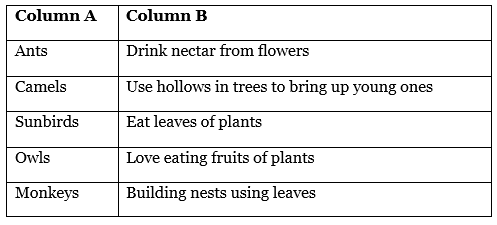Worksheet: Plants and Animals Live Together | Worksheets with solutions for Class 3 PDF Download
| Table of contents |

|
| Fill in the Blanks |

|
| True or False |

|
| One-Word Answer Type Questions |

|
| Multiple Choice Questions (MCQs) |

|
| Match the Following |

|
Fill in the Blanks
Q1: _______ use twigs from plants to build their nests.
Q2: _______ help in breaking down organic matter in the soil.
Q3: _______ stitch leaves together to build nests.
Q4: _______ rely on the branches of trees for resting and shelter.
Q5: _______ feed on leaves for energy before becoming butterflies.

True or False
Q1: Caterpillars use flowers for nesting.
Q2: Tailorbirds make their nests by stitching leaves together.
Q3: Moths only come out at night.
Q4: Barbets use tree hollows for nesting.
Q5: Elephants eat the bark of trees for food. 
One-Word Answer Type Questions
Q1: Which insect builds nests using leaves?
Q2: Name an animal that rests on tree branches for shelter.
Q3: What do butterflies drink from flowers?
Q4: Which small insect helps improve soil health by breaking down organic matter?
Q5: What do camels eat from plants?
Multiple Choice Questions (MCQs)
Q1: Which of the following animals use tree hollows for nesting?
(a) Ants
(b) Barbets
(c) Frogs
(d) Caterpillars
Q2: What do caterpillars feed on?
(a) Bark
(b) Leaves
(c) Nectar
(d) Twigs
Q3: Which of these insects builds nests using leaves?
(a) Butterflies
(b) Ants
(c) Moths
(d) Woodpeckers
Q4: What helps improve the soil by breaking down organic matter?
(a) Frogs
(b) Birds
(c) Earthworms
(d) Monkeys
Q5: Which animal feeds on grass and helps maintain grasslands?
(a) Elephants
(b) Monkeys
(c) Camels
(d) Frogs
Match the Following

You can access the solutions to this worksheet, here.
FAQs on Worksheet: Plants and Animals Live Together - Worksheets with solutions for Class 3
| 1. What are the different types of habitats where plants and animals live together? |  |
| 2. How do plants and animals depend on each other in an ecosystem? |  |
| 3. What is the importance of biodiversity in habitats? |  |
| 4. Can you give examples of symbiotic relationships between plants and animals? |  |
| 5. How do environmental changes affect the relationship between plants and animals? |  |

|
Explore Courses for Class 3 exam
|

|

















